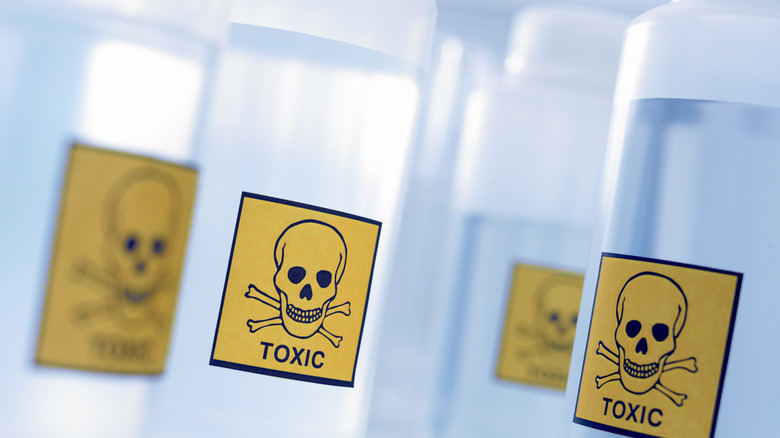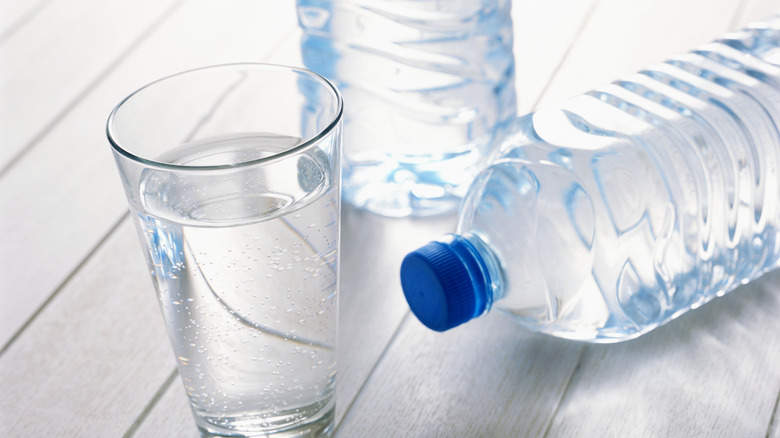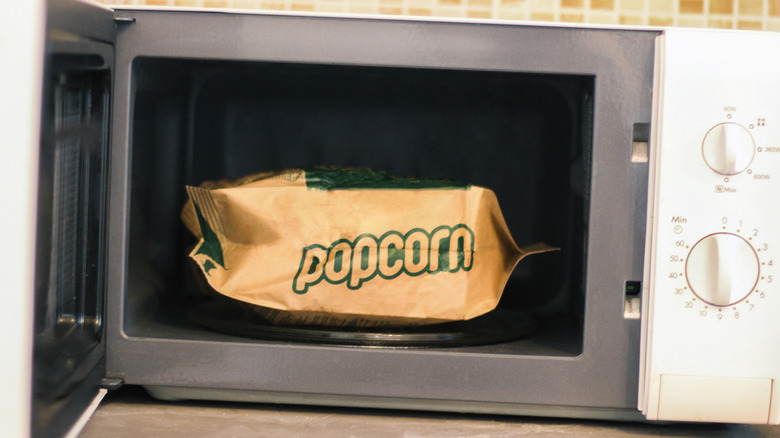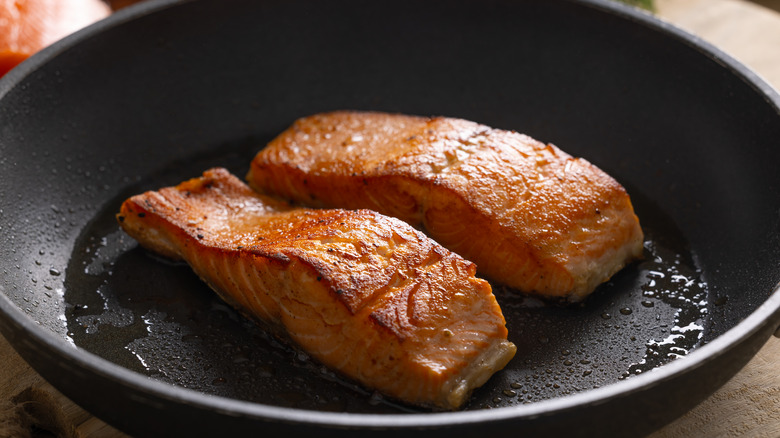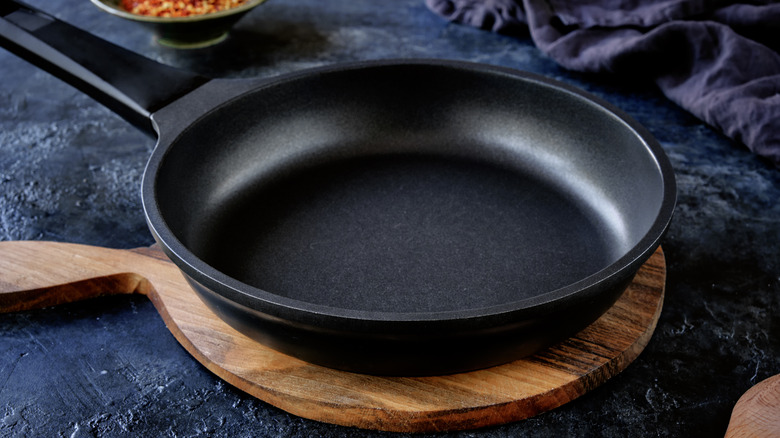5 Things You Should Know About The Forever Chemicals In Your Kitchen
In recent years, there's a good chance you've heard talk of scary-sounding "forever chemicals" that could be lurking in places like your drinking water, food supply, or household goods. In scientific terms, they're called PFAS (per- and polyfluoroalkyl substances), and they've been used since the '50s for a variety of reasons, but generally, because they're highly resistant to water, heat, and oil. They're fairly common in consumer goods — used to make clothes stain-resistant, for nonstick cookware (which make the best fried eggs) and packaging, and in fire extinguishing foam, just as a few examples.
The concern about them stems from theories that PFAS negatively affect human health, and the bad news is that this isn't just speculation, says Scott Bartell, a professor of environmental and occupational health at the University of California Irvine.
"There's some of them now that we've been studying for long enough and with enough detailed studies to demonstrate that they really do have negative consequences for health, including kidney cancer, increased cholesterol, potentially problems with pregnancy complications; there's a long list of either known or suspected health problems," he tells Chowhound.
While some PFAS are now banned, this doesn't fix everything, as the chemicals can soak into earth and water, can take centuries to degrade, and can build up in the human body over time. But the silver lining is that there's enough information out there that you can make choices that will reduce your exposure to them, and lower your health risk.
Water is your most likely exposure but bottles aren't necessarily the answer
According to Scott Bartell, the most likely place you'll encounter PFAS at home is your tap. "The best [estimate] that we have is probably from the U.S. Geological Survey, which is that nearly 50% of people probably have PFAS in their water," he says.
The reason for this is not that PFAS are actively added to drinking water, but rather that they just end up there after leaching in from industrial sites, landfills, military bases, and other places where PFAS are actively used. As Bartell notes, this hasn't been helped by the fact that industries were effectively allowed to emit as many PFAS as they liked without limit for some 50 to 60 years. Even though PFAS are now better regulated, those previously emitted chemicals still stick around for lifetimes.
The solution to this is not to switch to bottled water, though, says Bartell. "Bottled water is a little less regulated than tap water. And so there's no guarantee that it's going to be PFAS-free." Correspondingly, a 2021 study of over 100 bottled water brands found PFAS in 39 of them — in such cases, the PFAS are typically in the water itself, not the bottle. "There's no guarantee, but [PFAS] are not normally used in plastics manufacturing," says Bartell.
You can get your water tested and filtered
Fortunately, the Biden administration has imposed new rules that will require testing and reductions of PFAS in tap water (via the United States Environmental Protection Agency). However, water suppliers have five years to meet requirements, so Scott Bartell suggests taking your own steps in the meantime. "If you have PFAS in your water, I would not wait for five years," he warns.
That means testing to see if PFAS are actually there, but few Americans do this at present. A 2024 survey looking at Americans awareness and understanding of forever chemicals conducted by water treatment company Culligan found that 17% of American millennials and just 5% of boomers have tested for PFAS.
Testing can cost hundreds of dollars for higher-caliber labs, though so Bartell points out that you can lean on other resources if that's not an option. He says, "Some states like California require that water systems that have PFAS disclose that to their customers. You can also find there are websites like Environmental Working Group have some information about where PFAS have been found in water supplies."
If present, you can filter PFAS out — you'll want to look for NSF-certified water filters, although Bartell notes that they're imperfect. "They're only certified to lower the concentration to a certain level that's actually higher than the EPA standard."
You'll also want to remember to change the filters regularly to keep them working properly, he adds — and ensure all potential drinking water is filtered; some people may forget their refrigerator's water dispenser filter, for example.
Watch out for packaged foods
If your water supply doesn't have PFAS, that's good news, but you're not out of the woods. "For people that don't have PFAS in the water, diet is probably the next largest source of exposure," says Scott Bartell.
Specifically, they tend to be used in grease- or liquid-proof food packaging: Fast food wrappers, ice cream containers, microwave popcorn bags, and pizza boxes are a few common places they can be found. Tests on PFAS in human bodies have confirmed that these chemicals seem to be making their way from food packaging into people, too. According to Bartell, "People who consume packaged food more often tend to have higher PFAS concentrations in their blood than people who are cooking more at home, or already doing something that will help them reduce those exposures."
Fortunately, bans targeting PFAS in food packaging have been imposed in at least 20 states (with more likely on the way), including California, New York, Washington, and Colorado. However, if you're located in a state without such bans, it probably won't be clear which types of food packaging contain PFAS. "There are no labeling laws requiring these manufacturers of food packaging to actually say whether they contain PFAS," says Bartell.
You can't cook PFAS out of food
Even if you're not eating microwave popcorn and pizza, PFAS can still be in your food. For example, they can end up in meat if an animal eats contaminated feed. Scott Bartell points to some foods where elevated levels of PFAS have been detected: "There's lots of foods they appear in, but they tend to be at higher levels in fish and other seafood, shellfish and then eggs. They seem to really like to bind to the albumin in eggs."
For seafood, this is likely due to PFAS in the water. But regardless of the type of food, if has these chemicals, there's no easy way to remove them. Professor Bartell says that they can't be treated like foodborne pathogens and cooked out by heating to a safe temperature. "PFAS, they have these very strong carbon-fluorine bonds that just don't break down easily. So [heat] doesn't hurt the chemicals. You might move them around by heating them, but you're not gonna kill the chemicals or denature them," he explains.
Bartell suggests that stopping PFAS from getting into food in the first place would be ideal, although it's a long-term goal. "You can't avoid these entirely...hopefully we can reduce the amount of pollution from these chemicals and stop it upstream [in the food supply]." In any case, it's still better to eat fresh, home-cooked food instead of packaged, which is more likely to be exposed to PFAS.
Don't worry so much about that nonstick pan
One other place PFAS can hide in your kitchen is in nonstick cookware, such as Teflon pans. However, there may be a lot less to worry about here. Professor Scott Bartell notes that while nonstick pans used to be manufactured with actively harmful PFAS, that's arguably not the case anymore (bear in mind that PFAS is a broad category of chemicals, so there's some debate over what is and isn't a PFAS).
"Teflon itself is like a polymer that some people classify as a PFAS and other people don't. We think the polymer is safer," he explains. Studies looking into this issue haven't found that people who use nonstick pans have more PFAS concentrated in their body than those who don't, and that the pans generally aren't linked with a worrying level of exposure.
As an expert, Bartell says he doesn't think nonstick pans should be a cause for concern. Still, he suggests it may be wiser to avoid cooking with a particularly old, beat-up nonstick pan, just to be on the safe side. "Unless you're burning the Teflon or it's extremely scratched up, you're probably not releasing much of the monomer PFAS chemicals, the ones that we're really worried about. If the pan is in good shape, you're not overheating it, and if you're treating it as you should, it's probably not going to be contributing significantly."
